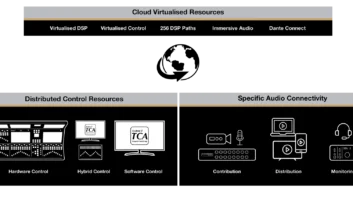There has been consistent growth in consumer demand for content in recent years. As video on demand (VoD) grows in popularity, consumers are becoming more and more acquainted with having access to a wealth of high-quality shows. As the space becomes increasingly competitive, productions are looking at tech alternatives to improve efficiencies within their processes. Many are turning to the cloud to facilitate improvements within their workflows. Creating a sophisticated content ingest process is a hugely important step in content management, however can the process be adapted to meet remote processes? And can it be done without compromising on key ingest features, such as data processing and management?
What considerations are important when adopting remote ingest?
The method used to ingest content hugely impacts production. Production teams need efficient and organised workflows to manage the reams of data-heavy video content within media. There are numerous practices which can be adopted to ensure that content is managed effectively. Saving content as both high resolution and proxy version files improves the workflow of remote productions, enabling faster and more accessible editing of content. Building a file-naming convention and metadata into content upon ingestion enables media asset management (MAM) systems to maximise the utilisation of content, ensuring that return on investment is amplified. Additionally, having timecoding and the syncing of audio incorporated in the ingestion process improves the editing process.
Delivering these services at ingest is available using a hardware-based solution, but can it be repeated when utilising cloud-based infrastructures? The latest platforms within broadcast have been developed to maintain the standards and features of content ingestion within cloud working. High-quality codecs can be recorded directly into the cloud from SRT and NDI feeds, whilst ‘edit-while-capture’ and the other aforementioned features can be supported with no other hardware than cameras and an encoder box.
Why is the industry turning to cloud working?
The primary driver of the swap to cloud working is cost. With much of the hardware being removed from the process, media companies are saving thousands from switching to remote production. The flexibility and scalability of cloud-based production provides businesses with significant cost savings. If a production runs over, a cloud infrastructure can quickly and cheaply be dialled up for the duration of the project. It can then be scaled back once the extra capacity is no longer needed.
With the latest cloud platforms delivering ingest without compromising on features, turning to remote working is possible without losing quality. Multiple input feeds can be managed via cloud-based ingest tools, allowing premium broadcasts to take advantage of utilising the platforms. Maximising the monetisation of content is hugely important within the competitive media landscape. The efficiency of an intelligent ingestion tool paired with the adaptability of the cloud drives productivity and efficiency of productions.
As we move beyond the challenges of the past 18 months, flexibility is going to continue to be integral in all industries. Remote and cloud working not only allows editors and producers to work from home, but it also enables global post production infrastructures in which roles are filled based on talent and suitability, rather than location.
Transforming remote content ingestion workflows
With online networks being at the centre of productions, getting the right tools to provide suitable workflows is imperative. A lot of time can be wasted using inefficient systems within the post production process. Managing content correctly can transform workflows and enable editors to focus on their speciality, as opposed to managing the online interface.
An intelligent interface must provide users with hierarchal permission capability to ensure that the relevant information is displayed. For instance, an editor would need to see multiple screens with editing/selection tools, time stamps and detailed information regarding the feed. A producer may only need to see an overview of information. Smart workflows can improve the quality of content ingestion. For example, interfaces with edit-while-capture technology can streamline the process through removing downtime between capture and edit.
Additionally, creating a high-resolution and proxy version of content improves the speed in which content can be accessed and enables work to be completed on the proxy which is then reflected in the high-res file. The correct cloud-based interface will enable users to benefit from all features that are available to professionals utilising on-prem content ingestion, allowing all corners of the media industry access to a premium, cloud-based ingest solution.
Remote ingestion: an increasingly popular option?
Unsurprisingly, performing content ingest remotely is growing in popularity. Many organisations swapped to a cloud-based network due to travel and social distancing restrictions in 2020, however the majority are choosing to remain due to both its operational and cost efficiencies. As confidence grows, so do the infrastructures surrounding it. The need to remain flexible and scalable has never seemed more important within the media industry, and cloud-based ingestion provides a minimal hardware solution to users. With no compromise on the features available, nor the quality of ingestion, the industry can expect to see more and more businesses swap to cloud-based infrastructures.







